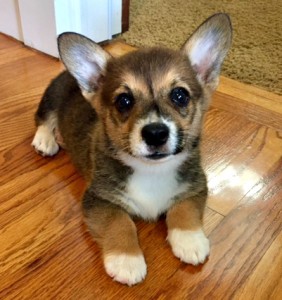Mark my words
Here’s a little fact I didn’t know until today. Puppies – like the one we brought home last summer – turn into “canine teenagers.” It can happen as soon as 4 months of age and can sometimes last until 18 months of age, depending on the breed. Do you know what that means? It means I now have THREE male teenagers in my house as well as one girl hovering in the “tween” stage. Lord, help me.
 During the past few weeks, 9-month-old Cooper the Corgi has gone crazy, and he’s taking me with him. Our sweet little puppy with bunny-soft fur and oversized ears has become a bigger, bossier version of himself.
During the past few weeks, 9-month-old Cooper the Corgi has gone crazy, and he’s taking me with him. Our sweet little puppy with bunny-soft fur and oversized ears has become a bigger, bossier version of himself.
This new version is a lot like our human teenagers. He needs me but doesn’t want me. He wants all the attention but wants to be left alone. He needs help but insists on independence. He’s constantly hungry but often turns up his nose at the food we offer. He is a four-legged ball of conflict.
I’m a little conflicted myself. When we got past the initial house-training and basic obedience commands, I thought the hard part of puppy-raising was over. I thought by now I’d be curled up on the sofa with a docile dog who obeys house rules. But apparently, I’ve got to survive puppy teendom before that happens.
According to my Google research, here are a few of the signs that a once precious pup has become a testy teenager: shedding, stubbornness, chewing, irritation toward other dogs, increased barking and an obsession with guarding – and marking – what he perceives to be his territory.
Experts say that helping a teenage dog burn off excess energy is important – as in, “a tired dog is a good dog.” So Cooper and I play fetch every day. But these past few weeks, the game goes like this:
Me: “Cooper! Go get the ball!”
(He bounds down the hallway chasing the bouncing ball and catches it in mid-air before trotting back toward me.)
Me: “Good boy! Good job! Now drop the ball!”
Cooper: (doggie thoughts) But I don’t want to drop the ball. The ball is mine. I love the ball. The ball squeaks when I bite it. I will not give you my ball… but I want you to throw the ball. Should I drop the ball? Chase the ball? Guard the ball? Shred the ball?
Me: “Cooper, you have to drop the ball if you want me to throw it. Drop it.”
Cooper: Maybe I’ll just circle around her with the ball in my mouth until I decide what to do.
 Cooper’s teenage angst has made fetch a lot trickier than it used to be. But the most pressing problem right now is what the dog experts call “marking.” My research has taught me that peeing is different from marking. The first one is simply a necessary bodily function. The second one is a dog’s way of saying “I live here. This is mine.” One website says that dogs mark territory the same way we humans put up fences – to show where our property lines are.
Cooper’s teenage angst has made fetch a lot trickier than it used to be. But the most pressing problem right now is what the dog experts call “marking.” My research has taught me that peeing is different from marking. The first one is simply a necessary bodily function. The second one is a dog’s way of saying “I live here. This is mine.” One website says that dogs mark territory the same way we humans put up fences – to show where our property lines are.
Cooper’s legs are only about four inches tall but that doesn’t stop him from lifting one to leave behind his canine calling card – even after I’ve taken him in the backyard where he sprinkles every tree and fence post he passes.
Lately, his favorite indoor target is an oversized stuffed animal – a dolphin – that belongs to our 11-year-old daughter. Sometimes the dolphin gets pushed off Kate’s bed and onto the floor. If it stays there too long, Cooper comes by and tries to put that fish back into water, if you know what I mean. We’ve had to clean that poor thing three times now.
In an attempt to un-mark anything Cooper might have marked without my knowledge, I had the carpets steam cleaned today, and I’m hopeful this doggie stage of development will pass soon. One article I read said that having a male dog neutered will help decrease marking behavior, so guess who now has an appointment with the veterinarian’s operating table?
Cooper has no idea what all those sprinkles are about to cost him.
 Gwen Rockwood is a mom to three great kids, wife to one cool guy, a newspaper columnist and co-owner of nwaMotherlode.com. Her book, “Reporting Live from the Laundry Pile” is available on Amazon.
Gwen Rockwood is a mom to three great kids, wife to one cool guy, a newspaper columnist and co-owner of nwaMotherlode.com. Her book, “Reporting Live from the Laundry Pile” is available on Amazon.
